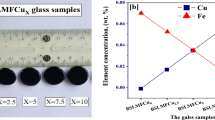Abstract
Titanium in normal melting conditions in air atmosphere present as Ti4+ ion in basic silicate glasses exhibited an ultra-violet cut-off in silicate glasses, viz. soda-magnesia-silica, soda-magnesia-lime-silica and soda-lime-silica glasses. This indicates that Ti4+ ion can be a good replacement for Ce4+ ion in producing UV-absorbing silicate glasses for commercial applications. The wavelength maxima at which the infinite absorption takes place in glasses was found to be around 310 nm against Ti-free blank glass in UV-region. The mechanism of electronic transition from O2- ligands to Ti4+ ion was suggested as L→ M charge transfer. The low energy tails of the ultra-violet cut-off were found to obey Urbach’s rule in the optical range 360–500 nm. The fluorescence spectra of these glasses were also studied and based on the radiative fluorescent properties it was suggested that the soda-lime-silica glass containing Ti4+ ion with greater emission cross-section would emit a better fluorescence than the corresponding soda-magnesia-lime-silica and sodamagnesia-silica glasses. The shift of emission wavelengths maxima towards longer wavelength in titania introduced silicate glasses was observed on replacement of MgO by CaO which may be attributed due to an increase in basicity of the glass system.
Similar content being viewed by others
References
Annapurna K, Dwivedi R N, Kumar A, Chaudhuri A K and Buddhudu S 1999Spectrochim. Acta 56 103
Annapurna K, Kumar A, Dwivedi R N, Hussain N S and Buddhudu S 2000Mater. Letts 45 23
Bae B S and Weinberg M C 1991J. Am. Ceram. Soc. 74 3039
Bamford C R 1962Phys. Chem. Glasses 36 189
Bamford C R 1977 inGlass science and technology (New York: Elsevier)2 54
Banerjee S and Paul A 1974J. Am. Ceram. Soc. 57 286
Bates T 1962Modern aspect of vitreous state (ed.) J D Mackenzie (London: Butterworths)2 p. 235
Cable M and Ziang Z D 1989aGlastech. Ber. 62 382
Cable M and Ziang Z D 1989bPhys. Chem. Glasses 30 237
Duram A and Fernandez Navarro J M 1985Phys. Chem. Glasses 26 126
Dwivedi R N and Nath P 1977Cent. Glass. Ceram. Res. Inst. Bull. 24 75
Dwivedi R N and Nath P 1978Cent. Glass. Ceram. Res. Inst. Bull. 25 5
Dwivedi R N and Nath P 1980Trans. Indian Ceram. Soc. 39 23
Evans D L 1970J. Am. Ceram. Soc. 53 418
Fuxi G 1992Optical and spectroscopic properties of glass (New York: Springer-Verlag) p. 155
Johnston W D 1964J. Am. Ceram. Soc. 47 198
Johnston W D 1965J. Am. Ceram. Soc. 48 184
Kuhl C, Rudow H and Weyl W A 1938Sprechsaal 71 118
Kumar S 1959Cent. Glass Ceram. Res. Inst. Bull. 63 99
Lee V J H and Bruckner R 1982Glastech. Ber. 55 219
Morinaga K, Yoshida H and Takebe H 1994J. Am. Ceram. Soc. 77 3113
Nath P and Douglas R W 1965Phys. Chem. Glasses 6 197
Nath P, Paul A and Douglas R W1965Phys. Chem. Glasses 6 203
Park S and Webb R S 1972Phys. Chem. Glasses 13 157
Paul A 1982Chemistry of glasses (New York: Chapman and Hall) 1st. ed. pp 230, 234, 250
Paul A and Douglas R W 1965Phys. Chem. Glasses 6 207
Singh R S and Singh S P 1998Phys. Chem. Glasses 39 140
Singh R S and Singh S P 2000Trans. Indian Ceram. Soc. 59 47
Singh R S and Singh S P 2001J. Mater. Sci. 36 1555
Singh S P and Kumar A 1992Phys. Chem. Glasses 23 61
Singh S P and Kumar A1995J. Mater. Sci. 30 2999
Singh S P, Prasad G and Nath P 1978aCent. Glass Ceram. Res. Inst. Bull. 25 38
Singh S P, Prasad G and Nath P 1978bJ. Am. Ceram. Soc. 61 377
Singh S P, Pyare R and Nath P 1986 inCollected papers XIV int. cong. on glass (Kolkata: Indian Ceramic Society)1 p. 215
Smith C F Jr and Condrate R A 1975Appl. Spectrosc. 29 79
Smith H L and Cohen A J 1963Phys. Chem. Glasses 4 173
Sreenivasulu M and Rao A S 2001Phys. Chem. Glasses 42 397
Steele F N and Douglas R W 1965Phys. Chem. Glasses 6 246
Steele F N 1966Absorption of iron in glasses, Ph D thesis, University of Sheffield, UK
Tress H J 1960Phys. Chem. Glasses 1 196
Weyl W A 1967Coloured glasses (Sheffield, UK: Society of Glass Technology)
Wong J and Angell C A 1976Glass structure by spectroscopy (New York: Marcel Dekker) p. 389
Wood D L and Remeika J P 1966J. Appl. Phys. 37 1232
Author information
Authors and Affiliations
Rights and permissions
About this article
Cite this article
Kumar, M., Uniyal, A., Chauhan, A.P.S. et al. Optical absorption and fluorescent behaviour of titanium ions in silicate glasses. Bull Mater Sci 26, 335–341 (2003). https://doi.org/10.1007/BF02707456
Received:
Revised:
Issue Date:
DOI: https://doi.org/10.1007/BF02707456




